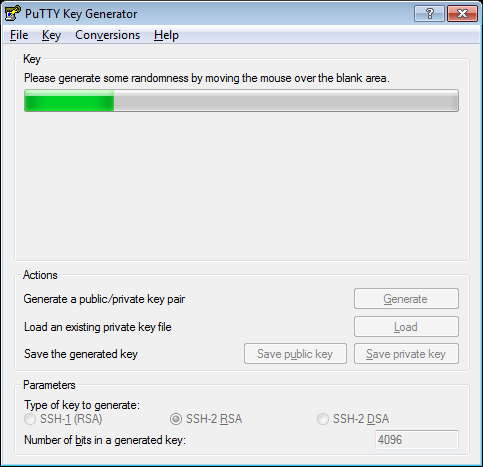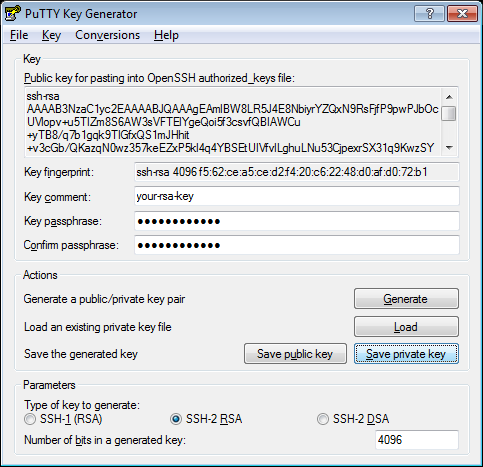Generate Private And Public Key Rsa
RSA(Rivest-Shamir-Adleman) is an Asymmetric encryption technique that uses two different keys as public and private keys to perform the encryption and decryption. With RSA, you can encrypt sensitive information with a public key and a matching private key is used to decrypt the encrypted message. Asymmetric encryption is mostly used when there are 2 different endpoints are involved such as VPN client and server, SSH, etc.
Usage Guide - RSA Encryption and Decryption Online. In the first section of this tool, you can generate public or private keys. To do so, select the RSA key size among 515, 1024, 2048 and 4096 bit click on the button. How to generate public/private key in C#. Asymmetric cryptography also known as public-key encryption uses a public/private key pair to encrypt and decrypt data. In.NET, the RSACryptoServiceProvider and DSACryptoServiceProvider classes are used for asymmetric encryption.
- Public key cryptography uses a public key to encrypt a piece of data, and then the recipient uses the private key to decrypt the data. The public and private keys are known as a key pair. Public key cryptography enables you to securely access your instances using a.
- Jun 17, 2014 RSACryptoServiceProvider is class which is used to generate public/private key pairs. This class provides several methods to generate keys and do encryption and decryption. Here is one sample code in C# which is generating public/private key pair and public ley as XML string.
- Generating Public/Private Keys In C# And.NET. How to generate public/private key in C#. Asymmetric cryptography also known as public-key encryption uses a public/private key pair to encrypt and decrypt data. In.NET, the RSACryptoServiceProvider and DSACryptoServiceProvider classes are used for asymmetric encryption.
Below is an online tool to perform RSA encryption and decryption as a RSA calculator.
For Java implementation of RSA, you can follow this article.
First, we require public and private keys for RSA encryption and decryption. Hence, below is the tool to generate RSA key online. It generates RSA public key as well as the private key of size 512 bit, 1024 bit, 2048 bit, 3072 bit and 4096 bit with Base64 encoded.
By default, the private key is generated in PKCS#8 format and the public key is generated in X.509 format.
Generate RSA Key Online
Public Key
RSA Encryption and Decryption Online
Below is the tool for encryption and decryption. Either you can use the public/private keys generated above or supply your own public/private keys.
Any private or public key value that you enter or we generate is not stored on this site, this tool is provided via an HTTPS URL to ensure that private keys cannot be stolen.
This tool provides flexibility for RSA encrypt with public key as well as private key along with RSA decrypt with public or private key.

If You Appreciate What We Do Here On Devglan, You Can Consider:
Private Key
- Like us at: or follow us at
- Share this article on social media or with your teammates.
- We are thankful for your never ending support.
Usage Guide - RSA Encryption and Decryption Online
In the first section of this tool, you can generate public or private keys. To do so, select the RSA key size among 515, 1024, 2048 and 4096 bit click on the button. This will generate the keys for you.
For encryption and decryption, enter the plain text and supply the key. As the encryption can be done using both the keys, you need to tell the tool about the key type that you have supplied with the help of radio button. By default, public key is selected. Then, you can use the cipher type to be used for the encryption. The different cipger options are RSA, RSA/ECB/PKCS1Padding and RSA/ECB/OAEPWithSHA-1AndMGF1Padding. Now, once you click the encrypt button the encrypted result will be shown in the textarea just below the button.
Remember, the encrypted result is by default base64 encoded.
Similarly, for decryption the process is same. Here, you need to enter the RSA encrypted text and the result will be a plain-text. You have both options to decrypt the encryption with public and private keys.
References
How To Generate Private And Public Key In Rsa Algorithm Java
Other Free Tools
To sign an assembly with a strong name, you must have a public/private key pair. This public and private cryptographic key pair is used during compilation to create a strong-named assembly. You can create a key pair using the Strong Name tool (Sn.exe). Key pair files usually have an .snk extension.
Note
In Visual Studio, the C# and Visual Basic project property pages include a Signing tab that enables you to select existing key files or to generate new key files without using Sn.exe. In Visual C++, you can specify the location of an existing key file in the Advanced property page in the Linker section of the Configuration Properties section of the Property Pages window. The use of the AssemblyKeyFileAttribute attribute to identify key file pairs was made obsolete beginning with Visual Studio 2005.
Create a key pair

Generate Rsa Public Key
To create a key pair, at a command prompt, type the following command:
sn –k <file name>
In this command, file name is the name of the output file containing the key pair.
The following example creates a key pair called sgKey.snk.
If you intend to delay sign an assembly and you control the whole key pair (which is unlikely outside test scenarios), you can use the following commands to generate a key pair and then extract the public key from it into a separate file. First, create the key pair:
Next, extract the public key from the key pair and copy it to a separate file:
Once you create the key pair, you must put the file where the strong name signing tools can find it. Wings of liberty key generator.
When signing an assembly with a strong name, the Assembly Linker (Al.exe) looks for the key file relative to the current directory and to the output directory. When using command-line compilers, you can simply copy the key to the current directory containing your code modules.
If you are using an earlier version of Visual Studio that does not have a Signing tab in the project properties, the recommended key file location is the project directory with the file attribute specified as follows: